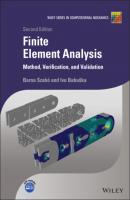Finite Element Analysis. Barna Szabó
Чтение книги онлайн.

Читать онлайн книгу Finite Element Analysis - Barna Szabó страница 39
Название: Finite Element Analysis
Автор: Barna Szabó
Издательство: John Wiley & Sons Limited
Жанр: Физика
isbn: 9781119426462
isbn:
and for
where
Since the exact solution is known, the exact value of the potential energy can be determined for any set of values of α, κ, c and
(1.107)
The exact values of the potential energy for the data
Table 1.2 Exact values of the potential energy for
| α |
|
α |
|
|---|---|---|---|
| 0.600 | −2.3728354978 | 1.000 | −1.0000000000 |
| 0.700 | −1.7571858289 | 1.500 | −0.5104166667 |
| 0.800 | −1.4176885916 | 2.000 | −0.3047619048 |
| 0.900 | −1.1799028822 | 3.000 | −0.1420634921 |
When α is a fractional number then derivatives higher than α will not be finite in
When α is an integer then all derivatives of
(1.108)